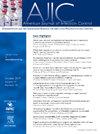Experiences when using different EHMR models: Implications for different designs and meeting user expectations
IF 3.8
3区 医学
Q2 INFECTIOUS DISEASES
引用次数: 0
Abstract
Background
New elastomeric half-mask respirator (EHMR) models without exhalation valves (EVs) or with exhalation valve filters (EVFs) are facilitating expanded use in health settings to reduce workers’ exposure to airborne hazards while acting as source control to prevent pathogen spread. The physical comfort of new models has not been assessed in comparison to previously used EHMRs with EVs.
Methods
Researchers assessed 1,962 health care and emergency medical service personnels’ self-reported adverse experiences from 2 cohorts while wearing EHMR models with EVs (cohort 1, n = 1,080) and without EVs or with EVFs (cohort 2, n = 882). Fisher exact test identified differences between the cohorts accounting for organizational factors when possible.
Results
Cohort 1 respondents experienced communication challenges and discomfort when wearing the EHMR > 1 hour statistically significantly more often than cohort 2. Cohort 2 respondents reported statistically significantly more instances of difficulty breathing, moisture buildup, being uncomfortable to wear < 1 hour, and being uncomfortably warm.
Conclusions
Discomfort is prevalent among end users and more often among those wearing EHMRs without an EV/with an EVF. As EHMR research and development advances, prevalence in use may increase for emergency and routine situations. Organizations may not only need guidance about respirator selection but also model-specific selection.
使用不同 EHMR 模型的经验:不同设计和满足用户期望的意义。
背景:不带呼气阀(EV)或带呼气阀过滤器(EVF)的新型弹性半面罩呼吸器(EHMR)有助于扩大在卫生环境中的使用,以减少工人暴露于空气传播的危害,同时起到源头控制的作用,防止病原体传播。与以前使用的带 EV 的超高压呼吸器相比,新型号的身体舒适度尚未得到评估:研究人员评估了来自两个队列的1962名医疗保健和紧急医疗服务人员在佩戴带EV(队列1,n=1,080)和不带EV或带EVF(队列2,n=882)的超高强度呼吸机时自我报告的不良体验。费雪精确检验确定了组群之间的差异,并在可能的情况下考虑了组织因素:组群 1 的受访者在佩戴超高清血压计超过 1 小时后出现交流障碍和不适的频率明显高于组群 2。第 2 组受访者报告的呼吸困难、湿气积聚、佩戴不舒适的情况明显多于第 2 组:不适感在最终用户中非常普遍,在佩戴无 EV/ 有 EVF 的 EHMR 的用户中更为常见。随着环境健康监测仪研发工作的推进,紧急情况和日常情况下的使用率可能会增加。各组织可能不仅需要呼吸器选择指导,还需要特定型号的选择指导。
本文章由计算机程序翻译,如有差异,请以英文原文为准。
求助全文
约1分钟内获得全文
求助全文
来源期刊
CiteScore
7.40
自引率
4.10%
发文量
479
审稿时长
24 days
期刊介绍:
AJIC covers key topics and issues in infection control and epidemiology. Infection control professionals, including physicians, nurses, and epidemiologists, rely on AJIC for peer-reviewed articles covering clinical topics as well as original research. As the official publication of the Association for Professionals in Infection Control and Epidemiology (APIC)

 求助内容:
求助内容: 应助结果提醒方式:
应助结果提醒方式:


